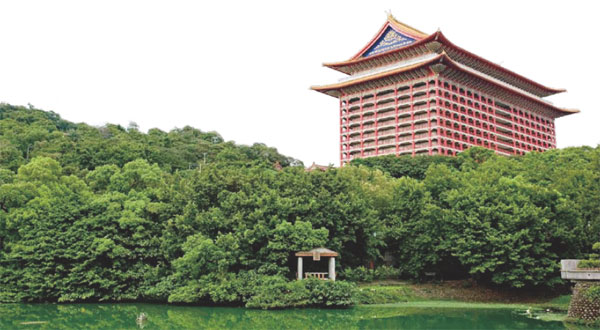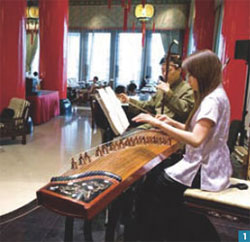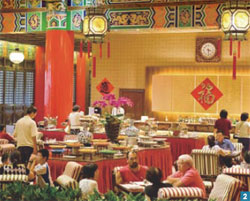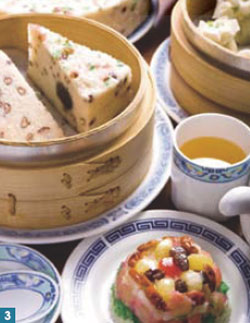The Grand Hotel: Taipei's Chinese Palace-style Iconic Landmark
When in Taipei exploring this city's charms, anytime you approach the Shilin District, the imposing Grand Hotel looms into view, perched atop the low, rounded Yuanshan. Its Chinese name translates literally as “Round Mountain Grand Hotel,” and this magnificent architectural expression most certainly is grandiose. It is one of Taipei's landmarks, and was rated one of the world's top ten hotels by Fortune magazine in 1968. Those who stayed here—a steady stream of high-level politicians, business executives, professionals and artists—understand the moment they step in that they would be enjoying one of the world's greatest hotel experiences. The hotel prides itself on courteous service in the classical Chinese style, and guests will surely be awed by the palace-style Chinese architecture. The hotel's main building, soaring 14 stories, was opened in 1973. The site on which the complex is built was formerly the site of the Taiwan Shinto Shrine, built by the Japanese during the colonial period (1895-1945). Since imperial times, it has been believed by feng-shui masters that a “dragon tail cave” had emerged here. You'll find an amazing 200,000 dragon-shaped carvings on site, leading to the attractive unofficial name “dragon palace.” Classical architectural rules have been followed, with intricate brackets atop great columns helping to support majestic flying eaves. The fine paintings and reliefs was all done by accomplished masters. Banquet/dining facilities are in the front half of the building, and guest rooms are toward the back. Room furnishings are a veritable chronicle of many Chinese imperial epochs stretching back into antiquity, and each of the eight floors dedicated as guest rooms highlights different dynasties' traditional folk art. Paintings and other two-dimensional artworks are all replicas of the priceless works housed in the nearby National Palace Museum. Fabrics you'll see in your room—beds, wall hangings, sofa slipcovers, and so on—have been meticulously chosen for authentic historical reference. The most prestigious/luxurious room is the Presidential Suite, which contains the writing desk once used by Chiang Kai-shek and the make-up table used by his wife, Madame Chiang, who was the prime mover behind the Grand Hotel project, feeling Taipei needed an international-caliber hotel to host important visitors. On the wall is a superb landscape painting in classical splash-ink style by celebrated master Zhang Da-qian. Many international celebrities used to stay in this suite when visiting Taiwan. Refined classical elegance such as this infuses the entire hotel; each way you turn, you'll see images of exquisite beauty. The interior design is made up of intricately carved marble columns and balustrades, bonsais and unusual stones, along with Ming Dynasty red-lacquer furniture pieces, a display of excellent Chinese craftsmanship. The imposing protective stone lions that stand in the concourse garden on the first level were donated to the Shinto shrine by the powerful Lin clan of Banqiao. Their former residential complex, Lin Family Garden, is now open for visit. The protective stone gods standing near the monumental archway is adorned with the famed calligraphy of master Yu You-ren, with the vigorous characters reading “Jiantan historical site.” Look closely at the doors of the main entrance and you'll see that on the darkened, stately floor-to-ceiling glass doors, it is lightly etched with the almost imperceptible characters “Long live the Republic of China.” Inside, the Golden Dragon Hall really does have intricate golden dragons; look closely and you'll notice that they are three-clawed, not the four or fiveclaw style Tel: (02) 2886-8888 Complementing the classic look and feel, the Grand Hotel is a place of the most modern service amenities. The gift shop brims with replica antiques and other upscale items. There is also a full range of recreational facilities, including a swimming pool, tennis courts, and fitness center. Not only would the Chinese kitchen easily please the emperor and his court, the Western chefs are also top-calibre, along with banquet facilities that can handle gatherings large and small. Be sure to try the classic soft red-bean cakes at Yuan Yuan restaurant, the silky outer layer made of glutinous rice, the filling red-bean paste sweet and fragrant. This was Madame Chiang's favorite snack. Yuan Yuan restaurant specializes in north China delicacies. Sophisticated palates also often come here specially for the taro paste with rock sugar, “eight treasures” rice pudding, and “emerald jade” steamed open dumplings. Each afternoon from 14:00 till 17:00, the grand lobby resounds with the elegant sounds of live traditional Chinese music. Sitting high up on its mountain perch, you can take in almost the whole of bustling Taipei before you spread out across the Taipei Basin. You feel the seclusion of being in a separated green oasis in the hills, yet a ride to the city center takes less than 15 minutes. Whenever you pass by on your way to and fro, take a moment and look up to this architectural masterpiece braced against an immovable mountain backdrop—for this, the Grand Hotel, is one of this island's most important, and most beautiful, historical landmarks.


 normally seen. In the imperial days, the fiveclaw auspicious beast was a symbol of the emperor, the three-claw version reserved for commoners. In the great high-ceilinged lobby, look up to see the large plafond in plum-blossom shape, embellished with meticulously rendered dragon and phoenix; the dragon and phoenix appear as harbingers of national prosperity, and the plum flower is a traditional symbol of resilience and also the national flower of the ROC. Another delight for your aesthetic sensibilities is the magnificent wall mural in copper on the grand staircase, depicting the times of the Duke of Zhou, supposedly a scene from 1,110 BC, showing Zhou's famed drafting of timeless Chinese ritual and music systems. The premieres of the famous Chinese movies “Hero” and “Red Cliff” both took place here.
normally seen. In the imperial days, the fiveclaw auspicious beast was a symbol of the emperor, the three-claw version reserved for commoners. In the great high-ceilinged lobby, look up to see the large plafond in plum-blossom shape, embellished with meticulously rendered dragon and phoenix; the dragon and phoenix appear as harbingers of national prosperity, and the plum flower is a traditional symbol of resilience and also the national flower of the ROC. Another delight for your aesthetic sensibilities is the magnificent wall mural in copper on the grand staircase, depicting the times of the Duke of Zhou, supposedly a scene from 1,110 BC, showing Zhou's famed drafting of timeless Chinese ritual and music systems. The premieres of the famous Chinese movies “Hero” and “Red Cliff” both took place here.Information Grand Hotel
Add: 1, Sec. 4, Zhongshan N. Rd.
Website: http://www.grand-hotel.org/en/

![Taiwan.gov.tw [ open a new window]](/images/egov.png)
